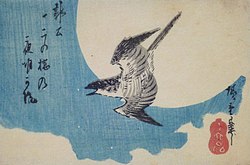ほととぎす
Hello, you have come here looking for the meaning of the word ほととぎす. In DICTIOUS you will not only get to know all the dictionary meanings for the word ほととぎす, but we will also tell you about its etymology, its characteristics and you will know how to say ほととぎす in singular and plural. Everything you need to know about the word ほととぎす you have here. The definition of the word ほととぎす will help you to be more precise and correct when speaking or writing your texts. Knowing the definition ofほととぎす, as well as those of other words, enriches your vocabulary and provides you with more and better linguistic resources.

ほととぎす (hototogisu): a print of a flying lesser cuckoo by Utagawa Hiroshige.
Japanese
Etymology 1
| Alternative spellings |
|---|
| 子規 時鳥 杜宇 杜鵑 田鵑 蜀魂 郭公 不如帰 怨鳥 |

From Old Japanese.
The final su is most likely す (su, “bird”, ancient term only found in old compounds).
Pronunciation
Noun
ほととぎす or ホトトギス • (hototogisu)
- lesser cuckoo (Cuculus poliocephalus)
- Synonyms: 卯月鳥 (uzukidori), 沓手鳥 (kutsutedori), 時つ鳥 (tokitsudori), 時の鳥 (toki no tori)
- Hypernym: 郭公 (kakkō)
- 1187, Senzai Wakashū (book 3, poem 161; also Hyakunin Isshu, poem 81)
- ほととぎす鳴きつる方をながむればただ有明の月ぞ残れる
Derived terms
- 杜鵑草 (hototogisu, “toad lily”)
- 杜鵑貝 (hototogisugai)
- 時鳥と兄弟 (Hototogisu to Kyōdai)
- 時鳥草 (hototogisusō)
- ただ取り山の時鳥 (tada tori yama no hototogisu)
- 鳴かぬなら鳴くまで待とう時鳥 (nakanunara naku made matō hototogisu)
- 目には青葉山時鳥初松魚 (me ni wa Aoba-yama hototogisu hatsugatsuo)
- 山ほととぎす (yama-hototogisu)
Proverbs
- あの声で蜥蜴くらうかほととぎす (ano koe de tokage kurau ka hototogisu)
- 鶯の卵の中のほととぎす (uguisu no kaigo no naka no hototogisu)
- 子で子にならぬほととぎす (ko de ko ni naranu hototogisu)
Etymology 2
| For pronunciation and definitions of ほととぎす – see the following entry. | ||
| ||
| (This term, ほととぎす (hototogisu), is the hiragana spelling of the above term.) For a list of all kanji read as ほととぎす, see Category:Japanese kanji read as ほととぎす.) |
References
Old Japanese
Etymology
From ほととぎ (poto2to2gi1, onomatopoeic imitation of the bird's cry) + す (-su, suffix representing birds).
Noun
ほととぎす (poto2to2gi1su)
- lesser cuckoo (Cuculus poliocephalus)
-
- 保登等芸須 今之来鳴者 餘呂豆代爾 可多理都具倍久 所念可母
- poto₂to₂gi₁su IMAsi KI₁NAKABA yo₂ro₂duyo₂ ni kataritugube₂ku OMOPOYUkamo
- If the cuckoo came and cried right now, I think it needs to go down throughout generations!
-
- (poetic) allusion to 飛幡 (To1bata, a placename)
- , text here
- 霍公鳥飛幡之浦爾敷浪乃屢君乎將見因毛鴨
- poto2to2gi1su To1bata-no2-ura ni siku nami1 no2 sikusiku ki1mi1 wo mi1mu yo2si moga mo
- (please add an English translation of this usage example)
- , text here
Derived terms
- 醜ほととぎす (siko2-poto2to2gi1su, “ugly cuckoo”)
- 元ほととぎす (moto2-poto2to2gi1su, “cuckoo that came and sang last year”)
- 山ほととぎす (yama-poto2to2gi1su, “mountain cuckoo”)
Descendants
- Japanese: ほととぎす (hototogisu)
